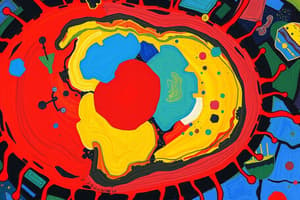Podcast
Questions and Answers
What is a key disadvantage of using preparation and staining techniques in microscopy?
What is a key disadvantage of using preparation and staining techniques in microscopy?
- They are less complicated than light microscopy.
- They are inexpensive and easy to use.
- They require minimal training.
- They can produce artefacts due to poor technique. (correct)
What is the correct formula to calculate the actual size of a cellular structure based on the image size and magnification?
What is the correct formula to calculate the actual size of a cellular structure based on the image size and magnification?
- Actual = Image x Magnification
- Magnification = Actual x Image
- Image = Actual + Magnification
- Actual = Image / Magnification (correct)
Which unit conversion is often recommended to make calculations easier when measuring cellular structures?
Which unit conversion is often recommended to make calculations easier when measuring cellular structures?
- Convert micrometres to millimetres.
- Convert centimetres to metres.
- Convert millimetres to micrometres. (correct)
- Convert millimetres to centimetres.
What is the value of 1 micrometre in metres?
What is the value of 1 micrometre in metres?
Why is it important to convert measurements into the same units before calculations?
Why is it important to convert measurements into the same units before calculations?
What is the primary function of the enzymes found in the matrix of mitochondria?
What is the primary function of the enzymes found in the matrix of mitochondria?
Which process is primarily associated with the Krebs cycle found in the mitochondrial matrix?
Which process is primarily associated with the Krebs cycle found in the mitochondrial matrix?
What structural feature do centrioles consist of?
What structural feature do centrioles consist of?
What role do ribosomes play in the cell?
What role do ribosomes play in the cell?
What type of proteins are primarily produced by the rough endoplasmic reticulum?
What type of proteins are primarily produced by the rough endoplasmic reticulum?
During which phase do centrioles replicate and migrate to poles in animal cells?
During which phase do centrioles replicate and migrate to poles in animal cells?
How do ribosomes appear when present in the cytoplasm?
How do ribosomes appear when present in the cytoplasm?
What is the primary role of the Golgi body in relation to proteins?
What is the primary role of the Golgi body in relation to proteins?
What is the primary function of the smooth endoplasmic reticulum?
What is the primary function of the smooth endoplasmic reticulum?
What structural feature characterizes the Golgi body?
What structural feature characterizes the Golgi body?
How are enzymes within lysosomes synthesized and transported?
How are enzymes within lysosomes synthesized and transported?
What is a primary function of lysosomes?
What is a primary function of lysosomes?
What occurs during autophagy?
What occurs during autophagy?
What process do lysosomes perform when they fuse with endocytic vesicles?
What process do lysosomes perform when they fuse with endocytic vesicles?
Which type of cell would likely have large Golgi bodies?
Which type of cell would likely have large Golgi bodies?
What is the function of the enzymes found in lysosomes?
What is the function of the enzymes found in lysosomes?
What is the conversion of 650 mm into micrometres (µm)?
What is the conversion of 650 mm into micrometres (µm)?
According to the fluid-mosaic model, what primarily makes up the plasma membrane?
According to the fluid-mosaic model, what primarily makes up the plasma membrane?
How is the actual size of an organelle calculated using the image size and magnification?
How is the actual size of an organelle calculated using the image size and magnification?
What does the selective permeability of the cell membrane signify?
What does the selective permeability of the cell membrane signify?
If a lung cell measures 25.5 nm, what is its size in millimetres?
If a lung cell measures 25.5 nm, what is its size in millimetres?
What does the term 'fluid' in the fluid-mosaic model refer to?
What does the term 'fluid' in the fluid-mosaic model refer to?
What happens to lipid-soluble molecules when they reach the cell membrane?
What happens to lipid-soluble molecules when they reach the cell membrane?
How many micrometres are in 1.5 meters?
How many micrometres are in 1.5 meters?
What is the main characteristic of diffusion?
What is the main characteristic of diffusion?
Which factor does NOT increase the rate of diffusion?
Which factor does NOT increase the rate of diffusion?
What distinguishes active transport from passive transport mechanisms?
What distinguishes active transport from passive transport mechanisms?
Which type of transport uses carrier proteins for polar molecules?
Which type of transport uses carrier proteins for polar molecules?
What is the primary role of mitochondria in cells involved in active transport?
What is the primary role of mitochondria in cells involved in active transport?
Which statement about osmosis is true?
Which statement about osmosis is true?
Which substance is transported via facilitated diffusion?
Which substance is transported via facilitated diffusion?
What effect do metabolic inhibitors have on active transport?
What effect do metabolic inhibitors have on active transport?
Flashcards are hidden until you start studying
Study Notes
Mitochondria
- Stalked particles are associated with ATP production via the electron carrier system (oxidative phosphorylation).
- The matrix of mitochondria contains enzymes for the Krebs cycle (aerobic respiration), mitochondrial DNA, and ribosomes.
- Mitochondrial DNA carries genetic information for mitochondrial replication.
- Ribosomes in the mitochondria are responsible for protein synthesis.
- Cells with high ATP demands, such as muscle cells, liver cells (for glycogen synthesis), and cells involved in active transport, possess numerous mitochondria.
Centrioles
- Small hollow cylinders (0.3 – 0.5μm long, 0.2μm diameter) containing 9 microtubule triplets.
- Occur in pairs in most animal cells.
- Replicate and migrate to opposite poles of the spindle during nuclear division.
- Spindle fibers (microtubules) control chromosome separation.
Ribosomes
- Tiny organelles (20nm diameter) composed of two subunits (large and small) made of protein and ribosomal RNA.
- Found individually in cytoplasm, in chains called polysomes, or attached to the endoplasmic reticulum.
- Function in protein synthesis by joining amino acids.
Endoplasmic Reticulum (ER)
- Network of flattened membrane sacs called cisternae serving as an internal transport system.
Rough Endoplasmic Reticulum (RER)
- Has ribosomes attached to its surface.
- Produces proteins that are transported through the cisternae often for secretion out of the cell.
- Secretory proteins are often directed to the Golgi body for packaging.
Smooth Endoplasmic Reticulum (SER)
- Lacks ribosomes.
- Involved in the production and transport of lipids.
Golgi Body
- Stack of flattened, membrane-bound sacs called cisternae.
- Cisternae are continuously formed at one end and pinched off as vesicles at the other.
- Secretory cells have large Golgi bodies.
- Functions as an internal processing and transport system:
- Production of glycoproteins.
- Packaging and secretion of proteins (e.g., enzymes).
- Formation of lysosomes.
Lysosomes
- Spherical organelles (0.2-0.5μm) found in most eukaryotic cells.
- Single-membrane-bound sacs containing digestive (hydrolytic) enzymes:
- Proteases break down proteins.
- Nucleases break down nucleic acids.
- Lipases break down lipids.
- Lysosomal enzymes are kept separate from the rest of the cell to prevent destruction.
- The enzymes are synthesized on the RER, transported to the Golgi apparatus, and packaged into Golgi vesicles that bud off to become lysosomes.
Lysosome Functions
- Digestion of material taken in by endocytosis: Lysosomes fuse with endocytic vesicles/vacuoles, releasing enzymes to digest the contents. Products are absorbed by the cytoplasm, leaving undigested remains which are released through exocytosis.
- Autophagy: Unwanted structures in the cell are engulfed and digested within lysosomes. These structures are enclosed in a single membrane (usually from smooth ER) and fuse with a lysosome, forming an "autophagic vacuole" for digestion. This is part of the regular turnover of cellular organelles (old ones replaced by new ones).
Calculating the Size of Cellular Structures
- Use the formula: Image size = Actual size x Magnification.
- Convert measurements to micrometres (µm) for cellular structures.
Cell Membrane
- Also known as the plasma membrane.
- Surrounds the cytoplasm of a cell.
- Controls the entry and exit of substances.
- Structure is described by the fluid-mosaic model.
Components of Cell Membrane
- Phospholipids form a bilayer that is constantly moving.
- Protein molecules are unevenly distributed throughout the membrane, creating a mosaic pattern.
Selective Permeability
- The type and distribution of proteins and phospholipids determine the selective permeability of the membrane.
- The phospholipid bilayer allows for rapid passage of lipid-soluble molecules but restricts the movement of ions and polar molecules.
Transport Across Membranes
- Movement of substances into or out of cells can occur through:
- Diffusion
- Facilitated diffusion
- Osmosis
- Active transport
Diffusion
- Net movement of molecules from high to low concentration until they are equally distributed.
- Passive process (i.e., doesn't require energy from respiration).
- Gaseous exchange occurs through diffusion.
Factors Affecting Diffusion Rate
- Higher concentration gradient increases the rate.
- Large surface area (e.g., microvilli) increases the rate.
- Shorter distance (e.g., single cell layer) increases the rate.
Facilitated Diffusion
- Transport of polar molecules (e.g., glucose, amino acids) across membranes.
- Involves channel proteins and carrier proteins.
- Passive process (i.e., doesn't require energy).
- Not inhibited by respiratory inhibitors (e.g., cyanide).
Active Transport
- Movement of molecules or ions against the concentration gradient (low to high concentration).
- Requires energy in the form of ATP produced by respiration.
- Involves carrier proteins.
Factors Affecting Active Transport
- Lowering temperature decreases the rate.
- Lack of oxygen decreases the rate.
- Metabolic and respiratory inhibitors (e.g., cyanide) decrease the rate.
- Cells involved in active transport have numerous mitochondria to provide ATP.
Osmosis
- Net movement of water molecules across a partially permeable membrane from a region of high water potential to a region of low water potential.
- Essentially diffusion of water molecules.
Studying That Suits You
Use AI to generate personalized quizzes and flashcards to suit your learning preferences.





